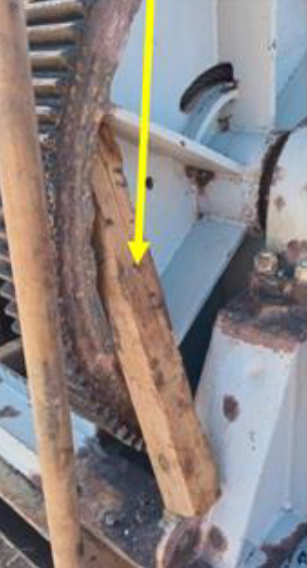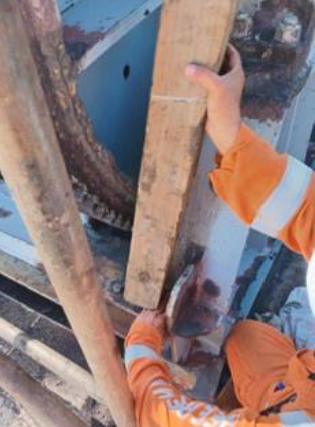Injury to little finger – LTI
What happened
A worker suffered an injury whilst painting an auxiliary winch drum following maintenance. While performing this work a wooden beam was used to prevent the drum from turning freely. Two painters, along with their supervisor, inspected their work area and conducted a toolbox talk before beginning to clean the winch drum base. While cleaning the auxiliary winch drum base, the painters needed to rotate the drum for better access. The two painters manually rotated the drum, one person holding it secured in position, while the other person repositioned the wooden beam to secure the drum. The two workers repeated this process twice without incident. However, the third time, one painter attempted to rotate the drum alone, as the other painter was not present. While positioning the wooden beam to secure the winch drum, the drum rotated back, trapping the his little finger between the beam and the winch base. This resulted in a broken finger.


What went wrong
- One person was trying to do a job that had already been established needed more than one person to do it safely;
- An improvised securing device was used (wooden beam), and this was seen as the most suitable and easy solution to secure the drum;
- Due to the general painting permit that was used for this job, there was no additional risk assessment covering the specifics of painting a winch that might potentially rotate;
- No further assessment was performed on how to properly secure the winch when the drum was in free rotation.
Lessons learned
- Stop the job when it cannot be performed safely;
- Don’t attempt to perform a two-person job alone; wait for assistance, even when this takes extra time;
- Ensure that a safe and designed-for-purpose securing methods are used, even when this takes more time to prepare;
- Do not use “general” permits and always assess the risks associated with changes introduced to an existing piece of equipment.
Members may wish to refer to:
Safety Event
Published: 25 September 2024
Download: IMCA SF 19/24
IMCA Safety Flashes
Submit a Report
IMCA Safety Flashes summarise key safety matters and incidents, allowing lessons to be more easily learnt for the benefit of all. The effectiveness of the IMCA Safety Flash system depends on Members sharing information and so avoiding repeat incidents. Please consider adding [email protected] to your internal distribution list for safety alerts or manually submitting information on incidents you consider may be relevant. All information is anonymised or sanitised, as appropriate.
IMCA’s store terms and conditions (https://www.imca-int.com/legal-notices/terms/) apply to all downloads from IMCA’s website, including this document.
IMCA makes every effort to ensure the accuracy and reliability of the data contained in the documents it publishes, but IMCA shall not be liable for any guidance and/or recommendation and/or statement herein contained. The information contained in this document does not fulfil or replace any individual’s or Member's legal, regulatory or other duties or obligations in respect of their operations. Individuals and Members remain solely responsible for the safe, lawful and proper conduct of their operations.
